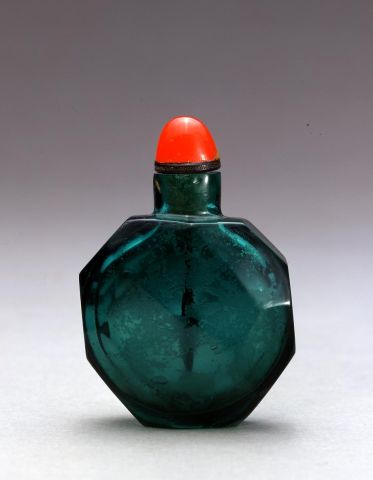
Bottle ID: 00323
GREEN EMERALD, OCTAGONAL W/MULTI-FACETED PANELS
Date: 1736-1770
Height: 36 mm
Glass, of octagonal faceted form with raised multi-faceted panels on each side, the emerald-green body suffused with crizzling on the interior.
Probably Imperial, attributed to the Palace Workshops, Beijing.
Similar Examples:
Chinese Glass of the Qing Dynasty, the Robert H. Claque Collection, 1987, Phoenix Art Museum, p. 48, no. 53.
Moss, Hugh, Victor Graham and Ka Bo Tsang. The Art of the Chinese Snuff Bottle - The J & J Collection, 1993, Vol. II, pp. 558-559, no. 332.
Provenance:
Robert Kleiner
Exhibited:
Annual Convention ICSBS Toronto, October 2007
The J & J Collection cited above has a very similar clear blue glass bottle of the same miniature size and with comparable irregular faceting. With its rare dark green tone, extensive crizzling on the interior and faceted form it is likely to be one of the earlier products of the Qianlong period. This may account for the somewhat irregular facets covering the bottle. Some of the early Qing glass exhibits a phenomenon described today as 'crizzling' where the interior surface of the object begins to deteriorate and becomes unstable. It is generally accepted that this is a bad recipe in the glass with the alkaline content being disproportionate to the mix, which is to say, too much soda and insufficient lime. It has been suggested in the past that crizzling is caused by the introduction of smashed Western glass into the mix and that this was unwittingly done by the craftsmen from Guangzhou at the Palace over three decades, in the belief that they were creating a stronger glass with greater clarity. This is now thought to be unlikely, although the Palace artisans did recycle their glass. Whatever the reason, over time the opposite has proved true as crizzling has occurred in these pieces. Crizzling is only visible when the glass has completely cooled and can often take up to a year to reveal itself, therefore accounting for the survival of these pieces which would have been judged as satisfactory by the artisans immediately after the glass making process was complete.

 English
English 中文
中文